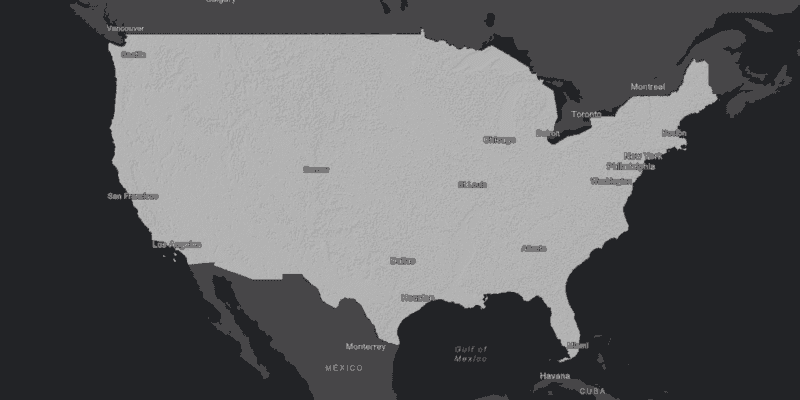Load a raster from a service, then apply a function to it.

Use case
Raster functions allow processing operations that can be applied to one or more rasters on the fly. Functions can be applied to rasters that come from a service. A land survey agency may apply hillshade and aspect functions to rasters with elevation data in order to better determine the topography of a landscape and to make further planning decisions.
How to use the sample
Pan and zoom to explore the raster function applied to the raster layer.
How it works
- Create the
ImageServiceRasterreferring to the image server URL. - Create the
RasterFunctionfrom a JSON string. - Get the arguments of the raster function with
rasterFunction.getArguments(). - Get the names of the raster arguments with
rasterFunctionArguments.getRasterNames(). - Set the raster argument with
rasterFunction.setRaster(rasterName, imageServiceRaster). - Create a new
Rasterreferring to the raster function. - Create a
RasterLayerto visualize the computed raster. - Display the raster.
Relevant API
- ImageServiceRaster
- Raster
- RasterFunction
- RasterFunctionArguments
- RasterLayer
About the data
The sample applies a hillshade function to a raster produced from the National Land Cover Database, NLCDLandCover2001. You can learn more about the hillshade function in the ArcMap documentation.
Additional information
The raster function computation happens locally on the client device.
Tags
function, layer, raster, raster function, service
Sample Code
/*
* Copyright 2017 Esri.
*
* Licensed under the Apache License, Version 2.0 (the "License"); you may not
* use this file except in compliance with the License. You may obtain a copy of
* the License at
*
* http://www.apache.org/licenses/LICENSE-2.0
*
* Unless required by applicable law or agreed to in writing, software
* distributed under the License is distributed on an "AS IS" BASIS, WITHOUT
* WARRANTIES OR CONDITIONS OF ANY KIND, either express or implied. See the
* License for the specific language governing permissions and limitations under
* the License.
*/
package com.esri.samples.raster_function;
import java.io.File;
import java.io.FileNotFoundException;
import java.util.Scanner;
import javafx.application.Application;
import javafx.scene.Scene;
import javafx.scene.control.Alert;
import javafx.scene.layout.StackPane;
import javafx.stage.Stage;
import com.esri.arcgisruntime.ArcGISRuntimeEnvironment;
import com.esri.arcgisruntime.layers.RasterLayer;
import com.esri.arcgisruntime.loadable.LoadStatus;
import com.esri.arcgisruntime.mapping.ArcGISMap;
import com.esri.arcgisruntime.mapping.BasemapStyle;
import com.esri.arcgisruntime.mapping.view.MapView;
import com.esri.arcgisruntime.raster.ImageServiceRaster;
import com.esri.arcgisruntime.raster.Raster;
import com.esri.arcgisruntime.raster.RasterFunction;
import com.esri.arcgisruntime.raster.RasterFunctionArguments;
public class RasterFunctionSample extends Application {
private ImageServiceRaster imageServiceRaster; // keep loadables in scope to avoid garbage collection
private MapView mapView;
@Override
public void start(Stage stage) {
try {
// create stack pane and application scene
StackPane stackPane = new StackPane();
Scene scene = new Scene(stackPane);
// set title, size, and add scene to stage
stage.setTitle("Raster Function Sample");
stage.setWidth(800);
stage.setHeight(700);
stage.setScene(scene);
stage.show();
// authentication with an API key or named user is required to access basemaps and other location services
String yourAPIKey = System.getProperty("apiKey");
ArcGISRuntimeEnvironment.setApiKey(yourAPIKey);
// create a map with the dark gray basemap style
ArcGISMap map = new ArcGISMap(BasemapStyle.ARCGIS_DARK_GRAY);
// create a map view and set the map to it
mapView = new MapView();
mapView.setMap(map);
// create an image service raster from an online raster service
imageServiceRaster = new ImageServiceRaster("https://sampleserver6.arcgisonline" +
".com/arcgis/rest/services/NLCDLandCover2001/ImageServer");
imageServiceRaster.loadAsync();
imageServiceRaster.addDoneLoadingListener(() -> {
if (imageServiceRaster.getLoadStatus() == LoadStatus.LOADED) {
// create raster function from local json file
File jsonFile = new File(System.getProperty("data.dir"), "./samples-data/raster/hillshade_simplified.json");
try (Scanner scanner = new Scanner(jsonFile)) {
// read in the complete file as a string
String json = scanner.useDelimiter("\\A").next();
RasterFunction rasterFunction = RasterFunction.fromJson(json);
RasterFunctionArguments arguments = rasterFunction.getArguments();
// apply the raster function
arguments.setRaster(arguments.getRasterNames().get(0), imageServiceRaster);
// create a new raster from the function definition
Raster raster = new Raster(rasterFunction);
// create raster layer and add to map as operational layer
RasterLayer hillshadeLayer = new RasterLayer(raster);
// add the hillshade raster layer to the map
map.getOperationalLayers().add(hillshadeLayer);
hillshadeLayer.addDoneLoadingListener(() -> {
if (hillshadeLayer.getLoadStatus() == LoadStatus.LOADED) {
// set viewpoint on the raster
mapView.setViewpointGeometryAsync(hillshadeLayer.getFullExtent(), 150);
} else {
Alert alert = new Alert(Alert.AlertType.ERROR, "Failed to load the hillshade raster layer");
alert.show();
}
});
} catch (FileNotFoundException e) {
Alert alert = new Alert(Alert.AlertType.ERROR, "Failed to locate raster function json");
alert.show();
}
} else {
Alert alert = new Alert(Alert.AlertType.ERROR, "Failed to load image service raster");
alert.show();
}
});
// add the map view to stack pane
stackPane.getChildren().addAll(mapView);
} catch (Exception e) {
// on any error, display the stack trace.
e.printStackTrace();
}
}
/**
* Stops and releases all resources used in application.
*/
@Override
public void stop() {
if (mapView != null) {
mapView.dispose();
}
}
/**
* Opens and runs application.
*
* @param args arguments passed to this application
*/
public static void main(String[] args) {
Application.launch(args);
}
}